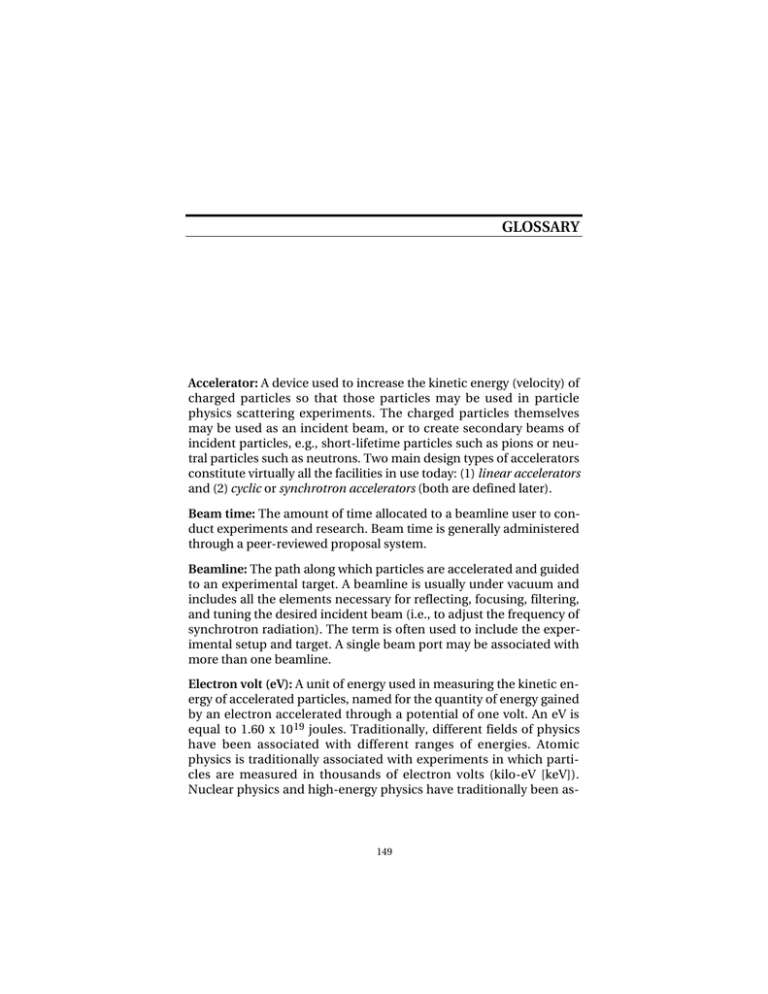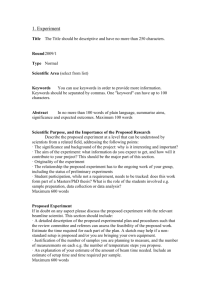GLOSSARY
advertisement

GLOSSARY Accelerator: A device used to increase the kinetic energy (velocity) of charged particles so that those particles may be used in particle physics scattering experiments. The charged particles themselves may be used as an incident beam, or to create secondary beams of incident particles, e.g., short-lifetime particles such as pions or neutral particles such as neutrons. Two main design types of accelerators constitute virtually all the facilities in use today: (1) linear accelerators and (2) cyclic or synchrotron accelerators (both are defined later). Beam time: The amount of time allocated to a beamline user to conduct experiments and research. Beam time is generally administered through a peer-reviewed proposal system. Beamline: The path along which particles are accelerated and guided to an experimental target. A beamline is usually under vacuum and includes all the elements necessary for reflecting, focusing, filtering, and tuning the desired incident beam (i.e., to adjust the frequency of synchrotron radiation). The term is often used to include the experimental setup and target. A single beam port may be associated with more than one beamline. Electron volt (eV): A unit of energy used in measuring the kinetic energy of accelerated particles, named for the quantity of energy gained by an electron accelerated through a potential of one volt. An eV is equal to 1.60 x 10 19 joules. Traditionally, different fields of physics have been associated with different ranges of energies. Atomic physics is traditionally associated with experiments in which particles are measured in thousands of electron volts (kilo-eV [keV]). Nuclear physics and high-energy physics have traditionally been as- 149 150 A Review of Reports on Selected Large Federal Science Facilities sociated with million electron volt (mega-eV [MeV]) and billion electron volt (giga-eV [GeV]) ranges, respectively. Flux: The beam flux is a measure of the number of incident particles per unit time. For charged particles, the beam flux is frequently measured as a current (in amperes) or charge per unit time. Insertion Device: Magnets called “wigglers” or “undulators” that are placed on straight sections of a synchrotron ring. The beamline that receives the radiation is called an insertion device beamline. Interferometer: An instrument that uses the principle of interference of electromagnetic waves for purposes of measurement. In 1887, Albert Michelson and Edward Morley performed one of the most famous experiments involving an interferometer; the experiment confirmed the constant speed of light. Linear Accelerator: A device in which charged particles are accelerated along a straight path at high speeds, and thus at high energy compared with their rest-mass energy. The particles “ride the crest” of radio frequency cavities along the beamline and, as a result, are typically delivered to the target in bunches or in high-intensity pulses. Some linear accelerators are used as “injectors” to the rings of cyclic accelerators. MW: Megawatt (MW [million watts]) is a standard unit of power. Neutron spallation facilities are measured in megawatts because the neutron yield is proportional to beam power, and nearly independent of incident beam energy up to several GeV beam energy.1 Neutron Scattering: The use of neutrons as an incident probe. Because a neutron has no charge but does have a magnetic moment, it interacts with magnetic and nuclear forces rather than electromagnetic or Coulomb forces. At thermal energies, the wavelength of a neutron is comparable to the separation of atoms in condensed matter. Thus, thermal neutrons display pronounced interference effects when they are scattered from condensed matter systems. The ______________ 1Martin, S., and C. W. Planner, “Accelerator Design Parameters for a European Pulsed Spallation Neutron Source,” presentation at 3rd European Particle Accelerator Conference, Berlin, Germany, March 24–28, 1992, pp. 435–437. Glossary 151 scattering of low-energy neutrons is sensitive to atomic and molecular length scales. Spallation: The creation of neutron beams by bombarding a heavy atomic nucleus (i.e., tungsten, uranium, mercury) with fast-moving particles, typically high-energy protons. As a result of this bombardment, the nuclei of the target atoms break up into many other secondary particles, including high-energy neutrons. Some neutrons are knocked out, or “spalled,” as a result of the impact and others are “boiled off” as the bombarded nucleus heats up. Spallation sources were created because neutrons have no charge and cannot be accelerated in the same manner as electrons or protons. Synchrotron accelerator: Ring-shaped particle accelerator in which the particles travel in synchronized bunches at a fixed radius. Acceleration of the charged particles is accomplished as they repeatedly pass through radio frequency cavities along the beamline, and magnets are used to bend and confine the beam to the circular path. Some synchrotron facilities use the charged particles, extracted from the ring, as an incident probe in scattering experiments. Other facilities create secondary incident beams, or use the X-ray synchrotron radiation emitted by the circulating charged particles as the probe. Synchrotron radiation: Energy lost in the form of electromagnetic radiation as particles travel along a circular path at high speeds within a synchrotron. The high intensity and brilliance of the X-rays in synchrotron radiation and the radiation’s spectral distribution over a wide range of energies make it a valuable tool in macromolecular crystallography when it is directed into controllable beamlines. The X-rays may be used to elucidate structures of biological macromolecules faster and more precisely than conventional Xray crystallography, and allow for the study of extremely large and extremely small molecules that was not possible when using previous methods. REFERENCES REVIEWED DOCUMENTS Astronomy and Astrophysics Survey Committee, Board on Physics and Astronomy, Commission on Physical Sciences, Mathematics, and Applications, National Research Council, The Decade of Discovery in Astronomy and Astrophysics, Washington, D.C.: National Academy Press, 1991 (available at http://www.nap.edu/ books/0309043816/html/index.html). Basic Energy Sciences Advisory Committee, Department of Energy, High Flux Isotope Reactor Upgrade and User Program—Oak Ridge National Laboratory, Review Committee Final Report, Washington, D.C.: DOE, October 23, 1998 (available at http://www. sc.doe.gov/production/bes/besac/hfir%20rpt.pdf). Basic Energy Sciences Advisory Committee Panel, Office of Energy Research, U.S. Department of Energy, Report of the Basic Energy Sciences Advisory Committee Panel on D.O.E. Synchrotron Radiation Sources and Science, Washington, D.C.: DOE, November 1997 (available at http://www-ssrl.slac.stanford.edu/lcls/papers/ syncpanel.pdf). Brown, Robert A., Hubble Second Decade Committee—The Hubble Data Archive: Toward the Ultimate Union Archive of Astronomy, Baltimore, Md.: The Space Telescope Science Institute, 2000a. 153 154 A Review of Reports on Selected Large Federal Science Facilities Brown, Robert A., Hubble Second Decade Committee—The Hubble Treasury Program: A New Class of Hubble Observations, Baltimore, Md.: The Space Telescope Science Institute, December 2000b. Committee to Assess the Policies and Practices of the Department of Energy to Design, Manage, and Procure Environmental Restoration, Waste Management, and Other Construction Projects, Board on Infrastructure and Constructed Environment, Commission on Engineering and Technical Systems, Characteristics of Successful Megaprojects, National Research Council, Washington, D.C.: National Academy Press, 2000 (available at http://www.science. doe.gov/SC-80/sc-81/PDF/NRC2000.pdf). Committee on Developing a Federal Materials Facilities Strategy, Commission on Physical Sciences, Mathematics, and Applications, National Research Council, Cooperative Stewardship: Managing the Nation’s Multidisciplinary User Facilities for Research with Synchrotron Radiation, Neutrons, and High Magnetic Fields, Washington, D.C.: National Academy Press, 1999 (available at http://books.nap.edu/html/cooperative_stewardship). Dressler, Alan, ed., HST and Beyond—Exploration and the Search for Origins: A Vision for Ultraviolet-Optical-Infrared Space Astronomy, Washington, D.C.: Association of Universities for Research in Astronomy, May 15, 1996 (available at http://origins.jpl.nasa.gov/ library/hst-and-beyond-report.pdf). Facilities Engineering Division, Code JX, NASA Headquarters, Facility Project Implementation Handbook (FPIH), Washington, D.C.: National Aeronautics and Space Administration, April 1999 (available at http://www.hq.nasa.gov/office/codej/codejx/). GAO. See U.S. General Accounting Office. Interagency Working Group on Neutron Science, Office of Science and Technology Policy, Report on the Status and Needs of Major Neutron Scattering Facilities and Instruments in the United States, Washington, D.C.: Office of Science and Technology Policy, June 2002 (available at http://www.ostp.gov/html/NeutronIWGReport. pdf). References 155 Major Materials Facilities Committee, Commission on Physical Sciences, Mathematics and Resources, National Research Council, Major Facilities for Materials Research and Related Disciplines, Washington, D.C.: National Academy Press, July 1984 (available at http://www.sc.doe.gov/production/bes/BESAC/major.pdf). National Science Foundation, Facilities Management and Oversight Guide, Washington, D.C.: NSF, November 8, 2002 (available at http://www.nsf.gov/bfa/lfp/document/facilities.pdf). National Science Foundation, Report of the NSF Panel on the Use of the Laser Interferometer Gravitational-Wave Observatory (LIGO), Washington, D.C.: NSF, 1996. Office of Basic Energy Sciences, U.S. Department of Energy, Report of the Basic Energy Sciences Advisory Committee on Neutron Source Facility Upgrades and the Technical Specifications for the Spallation Neutron Source, Washington, D.C.: Department of Energy, March 1998 (available at http://www.sc.doe.gov/production/ bes/besac/neutron%20source%20rpt.pdf). Operations and Scientific Research Sub-Panel, Report of the Review of the Laser Interferometer Gravitational Wave Observatory (LIGO), Hanford, Wash.: National Science Foundation, 2001. Panel on Neutron Sources, Basic Energy Sciences Advisory Committee, Neutron Sources for America’s Future, Washington, D.C.: U.S. Department of Energy, Office of Energy Research, DOE/ER-0576P, January 1993 (available at http://www.er.doe.gov/production/ bes/besac/Neutron%20source%20America%20Future.pdf). Structural Biology Synchrotron Users Organization (BioSync), Biological Applications of Synchrotron Radiation: An Evaluation of the State of the Field in 2002, San Diego Supercomputer Center, San Diego, Calif.: BioSync, October 2002 (available at http:// biosync.sdsc.edu/BioSync_Report_2002.pdf). Task Force on Science and Engineering Infrastructure, Science and Engineering Infrastructure for the 21st Century: The Role of the National Science Foundation, Washington, D.C.: National Science Foundation, November 2002. 156 A Review of Reports on Selected Large Federal Science Facilities U.S. General Accounting Office, Department of Energy: Opportunity to Improve Management of Major System Acquisitions, Report to the Chairman, Committee on Governmental Affairs, U.S. Senate, Washington, D.C.: GAO, GAO/RCED-97-17, November 1996 (available at http://www.science.doe.gov/SC-80/sc-81/PDF/rc97017. pdf). Working Group on Structural Biology at Synchrotron Radiation Facilities, Office of Science and Technology Policy, Synchrotron Radiation for Macromolecular Crystallography, Washington, D.C.: Office of Science and Technology Policy, January 1999 (available at http://www.ostp.gov/Science/html/cassman_rpt. html#Introduction). OTHER CITATIONS GAO. See U.S. General Accounting Office. Hodgson, Keith, and Eaton Lattman, “Survey of Structural Biology Beam Lines and Instrumentation and U.S. Synchrotron Centers— Needs and Opportunities for the Future,” San Diego, Calif.: San Diego Supercomputer Center, February 1998. Illingworth, Garth, et al., “UV-Optical from Space,” in Working Papers: Astronomy and Astrophysics Panel Reports, Washington, D.C.: National Academy Press, 1991. Martin, S., and C. W. Planner, “Accelerator Design Parameters for a European Pulsed Spallation Neutron Source,” presentation at 3rd European Particle Accelerator Conference, Berlin, Germany, March 24–28, 1992, pp. 435–437. Office of Space Science and Applications, Solar System Exploration Division, TOPS Science Working Group, TOPS: Toward Other Planetary Systems: A Report by the Solar System Exploration Division, Washington, D.C.: National Aeronautics and Space Administration, 1992. Report of the Basic Energy Sciences Advisory Committee Panel on Research Reactor Upgrades, Washington, D.C.: BESAC, March 1996. References 157 Sanders, G. H., electronic mail message to Aaron Kofner, 2003. U.S. Congress, Making Appropriations for Energy and Water Development for the Fiscal Year Ending September 30, 1996, and for Other Purposes, U.S. House of Representatives Report 104–293, October 26, 1995 (available at http://frwebgate.access.gpo.gov/cgi-bin/ getdoc.cgi?dbname=104_cong_reports&docid=f:hr293.104.pdf). U.S. Congress, Making Appropriations for Energy and Water Development for the Fiscal Year Ending September 30, 1998, and for Other Purposes, HR 105-271, n.d. U.S. General Accounting Office, Nuclear Health and Safety: More Can Be Done to Better Control Environmental Restoration Costs, Washington, D.C.: GAO, GAO/RECD-92-71, April 20, 1992a. U.S. General Accounting Office, Nuclear Waste: Defense Waste Processing Facility—Costs, Schedule, and Technical Issues, Washington, D.C.: GAO, GAO/RCED-93-183, June 17, 1992b.


![Chapter 12 2 [MS Word Document, 283.0 KB]](http://s3.studylib.net/store/data/007814251_2-e4ef09d20f4a8eef2d170e162941f5cc-300x300.png)




